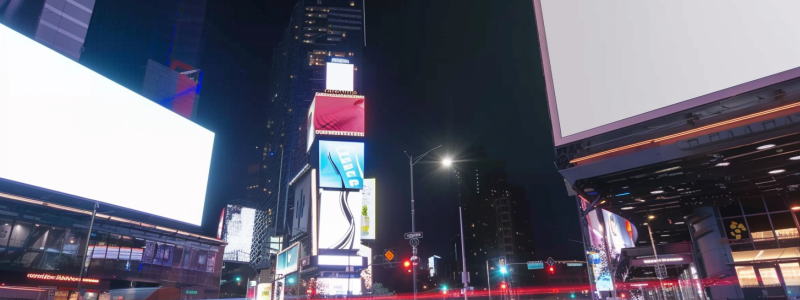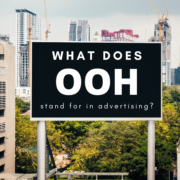Amidst the busy world of modern marketing, billboard advertising stands out as a potential tool for increasing a brand’s visibility. While digital marketing continues to grow, the physical presence of billboard advertising offers a unique combination of reach and impact that digital channels often struggle to achieve. However, before investing in billboard advertising, it is important to consider the return on investment (ROI) and how to use it effectively.
Understanding the ROI of billboard advertising is essential for any business owner contemplating this traditional yet powerful marketing channel. ROI, or Return on Investment, serves as a vital metric, helping businesses gauge the effectiveness of their advertising efforts in generating revenue compared to the cost incurred. In the context of billboard advertising, assessing ROI involves looking beyond the immediate visibility, delving into the influence on consumer behavior, brand recall, and ultimately, sales.
At bMedia, we have created this article to serve as a comprehensive guide for business owners who are considering billboard advertising as a strategy to promote their products or services. Our aim is to discuss the different types of billboards, their advantages, and how to measure and maximize your returns. Whether you are new to outdoor advertising or looking to improve your existing strategies, this guide aims to provide you with the necessary knowledge to make informed decisions, ensuring that your billboard advertising efforts are both effective and economically viable.

The Basics of Billboard Advertising
In the fast-paced world of today, getting the attention of potential customers is more difficult than ever. However, despite the rise of digital marketing, billboard advertising still plays a vital role in increasing brand visibility. To understand the ROI of billboard advertising, it’s essential to first understand what it is, why it matters, and how it can be a game-changer for businesses looking to make a significant impact in the marketplace.
What is Billboard Advertising? Billboard advertising is a form of outdoor advertising that uses large-scale print or digital displays to promote a product, service, or brand to the public. There are primarily three types of billboard advertising, each with its unique advantages:
- Digital Billboards: These are electronic displays that can change messages every few seconds, allowing for multiple advertisers on one billboard and dynamic content that can be updated in real-time.
- Traditional Billboards: Often referred to as static billboards, these are the standard billboards that display a single, non-changing advertisement printed on a large vinyl, fabric, or paper sheet.
- Mobile Billboards: These billboards are mounted on vehicles, allowing your advertisement to move around and reach different locations and audiences throughout the day.
Key Components of Effective Billboard Advertising
For billboard advertising to be effective, it must excel in several key areas. Understanding these components can help business owners maximize the impact of their billboard campaigns:
- Location: The placement of your billboard is crucial. High-traffic areas, major highways, and intersections with long wait times can increase visibility significantly.
- Visibility: A great location won’t matter if your billboard isn’t easily visible. Ensure there are no obstructions and that it’s placed at an angle conducive to oncoming traffic’s line of sight.
- Message Clarity: With only a few seconds to capture a viewer’s attention, your message needs to be concise and impactful. A clear, compelling call to action (CTA) alongside memorable visuals can make all the difference.
When used strategically, billboard advertising provides a unique opportunity for businesses to reach a large audience with their message. Effective billboard advertising is not just about raising awareness – it involves designing and placing billboards in a way that aligns with the business’s overall marketing goals and generates a positive ROI.
By keeping these fundamentals in mind, business owners can successfully navigate the complex world of billboard advertising and increase their brand visibility and customer engagement. With the right approach, billboards can be a powerful tool in a business’s marketing strategy, resulting in increased sales and brand recognition.
Measuring the ROI of Billboard Advertising
As businesses try to grasp the concept of understanding the ROI of billboard advertising, it’s important for owners to learn about the metrics and methods that contribute to effective measurement. Unlike digital advertising, where clicks and impressions can be easily tracked, calculating ROI on billboard advertising is not so straightforward. However, by adopting the right approach, you can assess the effectiveness of your billboard campaigns and make informed decisions to optimize your marketing budget.
Key Metrics for Billboard Advertising ROI
To measure the ROI of billboard advertising, we focus on both direct and indirect metrics, which together offer a comprehensive view of campaign performance:
- Impressions: The total number of times your billboard is seen. This is estimated based on the location’s traffic data and billboard visibility.
- Reach: The number of unique individuals who see your billboard. This differs from impressions, which may count the same individual multiple times.
- Brand Lift: An increase in brand awareness, consideration, or preference. This is often measured through market research before and after the billboard campaign.
- Engagement: Any measurable interaction that your billboard inspires, such as social media mentions, website visits, or an uptick in search queries related to your business.
- Sales Lift: The most direct measure of ROI, reflecting the increase in sales attributed to the billboard campaign. This requires tracking sales data before, during, and after the advertisement’s run.
Methods for Calculating ROI
Calculating the ROI of billboard advertising involves correlating the cost of your billboard campaign with the business outcomes it generates. Here are foundational steps to guide this calculation:
- Determine the Total Campaign Cost: This includes the cost of renting the billboard space, designing the advertisement, and any other associated expenses.
- Estimate the Campaign’s Impact: Utilize the above metrics to gauge the campaign’s effectiveness. For instance, use traffic data to estimate impressions and conduct pre- and post-campaign surveys to measure brand lift.
- Attribute Sales to the Campaign: Analyze sales data to identify any increases during and after the campaign. While attributing sales directly to billboards can be challenging, looking for correlations in time frames and geographic areas covered by the billboards can provide valuable insights.
- Calculate ROI: The formula for ROI is [(Return from Investment – Cost of Investment) / Cost of Investment] x 100. In this context, ‘Return from Investment’ refers to the monetary value of the outcomes attributed to the billboard campaign.
Implementing a mix of these metrics and methods offers a balanced approach to understanding the ROI of your billboard advertising efforts. While some metrics, like impressions and reach, provide immediate feedback on visibility, others, such as sales lift and brand lift, reveal the long-term value and impact of your campaign.
Effective ROI measurement empowers business owners to refine their billboard advertising strategies, allocate resources more efficiently, and ultimately, achieve greater market impact. As we move forward, remember that the goal is not just to calculate ROI but to understand it deeply enough to drive smarter, more profitable advertising decisions.
Factors Influencing ROI in Billboard Advertising
After establishing a foundation for measuring the ROI of billboard advertising, it’s pivotal to recognize the factors that can significantly influence these outcomes. Understanding these variables allows business owners to strategize more effectively, optimizing their billboard campaigns for maximum return. These factors range from the physical attributes of the billboard to the content it displays, each playing a crucial role in the campaign’s overall effectiveness.
Location and Visibility
- Traffic Volume: Areas with high traffic volume, especially during peak hours, can dramatically increase the number of impressions your billboard receives.
- Demographics: The characteristics of the population in the billboard’s vicinity should align with your target audience. Age, income, interests, and other demographic factors can influence the relevance and impact of your advertisement.
- Line of Sight and Visibility: The billboard’s placement and whether it’s easily visible without obstructions are crucial. Billboards at eye level or those facing oncoming traffic tend to have higher engagement rates.
Design and Message Clarity
- Simplicity of Design: With only a few seconds to capture attention, a clear, straightforward design with bold visuals and minimal text ensures your message is understood.
- Brand Consistency: Ensuring your billboard’s design is consistent with your overall brand image and messaging strengthens brand recall and contributes positively to ROI.
- Call to Action: An effective CTA can drive engagement, directing the audience towards a specific action, such as visiting a website or making a purchase.
Timing and Duration
- Campaign Timing: Aligning your billboard advertisement with specific events, seasons, or consumer buying patterns can enhance its relevance and impact.
- Exposure Duration: The length of time your billboard is displayed affects the number of people who see it. Longer campaigns have the potential to reach more people, but the diminishing return over time is a factor to consider.
Integration with Other Marketing Efforts
- Cross-Media Synergy: Billboards that are part of a larger, integrated marketing campaign tend to have a higher ROI. They can amplify other marketing channels by reinforcing the message or directing traffic to digital platforms.
- Tracking Mechanisms: Including a unique hashtag, QR code, or website URL on your billboard can help track its direct impact on web traffic, social media engagement, or specific promotions.
Understanding and utilizing these factors can significantly enhance the return on investment of billboard advertising. By carefully selecting the ideal location, designing an engaging advertisement, timing your campaign appropriately, and integrating it within a broader marketing strategy, businesses can not only achieve higher visibility but also drive meaningful engagement and sales. In the following section, we will explore effective strategies to maximize these factors, ensuring that your billboard advertising not only captures attention but also conveys your message compellingly to your target audience.

Maximizing the ROI of Billboard Advertising
Crafting an impactful billboard ad involves more than just bold visuals and catchy phrases. The design and messaging must work in harmony to not only grab attention but also convey your brand’s message effectively and drive action. This balance is crucial for maximizing the ROI of billboard advertising. Here are strategic guidelines to ensure your billboard’s design and messaging hit the mark.
Simplicity is Key
- Concise Messaging: Keep text minimal. Aim for a maximum of six words to ensure your message can be comprehended at a glance.
- Bold, Clear Fonts: Choose fonts that are easy to read from a distance. Avoid cursive or overly stylized fonts that might impair readability.
Make a Visual Impact
- High-Contrast Colors: Utilize contrasting colors for background and text to enhance readability. High contrast not only grabs attention but also improves legibility from afar.
- Use Compelling Imagery: A single, powerful image can tell a story more effectively than text. Ensure the image is relevant to your message and brand.
Focus on Branding
- Prominent Logo Placement: Your logo should be visible but not overpower the message. It’s about creating brand recall, not just logo recognition.
- Consistent Brand Identity: Ensure that your billboard design is consistent with your brand’s overall visual identity, including colors, fonts, and tone.
Craft a Clear Call to Action (CTA)
- Direct and Actionable: Your CTA should inspire immediate action or thought. Whether it’s visiting a website, calling a phone number, or simply planting a seed of curiosity, make it clear and compelling.
- QR Codes and Unique URLs: Including a QR code or a unique URL can directly measure engagement from the billboard. Ensure these elements are large enough to be noticed and scanned or remembered easily.
Engage Emotionally
- Evoke Emotion: Aim to strike an emotional chord with your audience. Whether it’s humor, happiness, nostalgia, or urgency, emotional engagement increases the likelihood of your message being remembered.
- Tell a Story: Even with limited space, your billboard can tell a story through visuals and succinct text. A narrative element can increase engagement and recall.
Test and Refine
- Mockups and Digital Previews: Before finalizing your design, test it through mockups or digital previews to see how it looks from various distances and angles.
- Feedback Loops: Gather feedback on your billboard designs from a diverse group of people to ensure the message is clear and the design is impactful.
Implementing these strategies can significantly enhance the effectiveness of your billboard advertising. A well-designed billboard with a clear, compelling message not only captures attention but also makes a lasting impression on viewers. By focusing on simplicity, visual impact, branding, and emotional engagement, you can create billboards that resonate with your audience and drive meaningful results, thereby maximizing the ROI of your billboard advertising campaign.
Timing and Placement
The timing and placement are solid proof of understanding the ROI of billboard advertising. Both can profoundly affect strategy via its visibility, relevance, and ultimately, its ROI. These decisions should be informed by a deep understanding of your target audience, their habits, and the competitive landscape. Here’s how to optimize these crucial factors for your billboard campaign.
Choosing the Right Location
- Audience Alignment: Select locations where your target demographic frequently travels. Utilizing traffic and demographic data can help identify these prime spots.
- High Traffic Areas: Opt for areas with high foot or vehicle traffic, but also consider the speed at which people are moving. Slower traffic means more time to view and absorb your message.
- Competitive Presence: Being aware of where your competitors place their billboards can offer strategic insights. You might choose to be nearby to intercept their audience or opt for less cluttered spaces to stand out.
Leveraging Seasonality and Events
- Seasonal Campaigns: Adjust your billboard content and placement to align with seasonal shopping trends, holidays, or events that resonate with your target audience.
- Event-Driven Advertising: Capitalizing on local events, concerts, sports games, or conventions by placing billboards strategically can increase relevance and engagement.
Duration and Frequency
- Exposure Duration: The length of your campaign should balance cost with exposure. Longer campaigns increase the chance of being seen but evaluate the diminishing returns over time.
- Frequency vs. Saturation: Repeated exposure is key to brand recall, but too much saturation can lead to ad fatigue. Find the balance that keeps your message fresh and engaging.
Testing and Adaptation
- Pilot Campaigns: Running short-term pilot campaigns in different locations can provide insights into what works best before committing to a longer-term investment.
- Adaptation: Be prepared to adapt your strategy based on performance. This might mean changing the billboard’s content, its location, or the timing of your campaign based on initial feedback and results.
Integration with Broader Marketing Campaigns
- Cross-Channel Synergy: Ensure your billboard advertising complements and amplifies your other marketing efforts. Consistent messaging across channels reinforces your brand and can boost overall campaign effectiveness.
- Digital Integration: Consider integrating digital actions with your billboard. Encouraging social media engagement or visits to your website can extend the interaction beyond the physical viewing.
To make the most out of your billboard advertisements, it’s essential to plan the timing and placement carefully. The objective is not only to grab attention but also to ensure that it feels relevant and tailored to the audience’s needs and interests. This strategic approach to timing and placement is critical in maximizing the return on investment of billboard advertising, ensuring that your messages resonate deeply and drive the desired actions.
Challenges and Considerations
Billboard advertising can be a powerful tool for gaining visibility and engagement. It also presents unique challenges that require careful consideration. Thus, to ensure that your investment in billboard advertising yields the best possible returns you need to understand these challenges. In this section, we’ll discuss some of the key hurdles and critical factors.
Budgeting and Cost Efficiency
- Upfront Investment: Billboard advertising requires an initial investment that can be substantial, especially in high-traffic locations. Planning your budget to accommodate this cost is crucial.
- Cost-Benefit Analysis: Evaluate the potential return on investment relative to the cost. High-traffic areas may warrant the higher price due to increased visibility, but the effectiveness must be measured against your specific business goals.
Design and Message Adaptation
- Creative Constraints: The need for simplicity in design and messaging can be challenging. It demands creativity to convey your message effectively within these constraints.
- Cultural and Environmental Sensitivity: Billboards are public and highly visible. Ensuring your content is culturally sensitive and appropriate for the area is essential to avoid backlash.
Regulatory and Zoning Restrictions
- Legal Compliance: Billboard advertising is subject to local, state, and federal regulations, which can vary significantly. Understanding and adhering to these regulations is vital to avoid fines or forced removal of your advertisement.
- Zoning Laws: Certain areas may have restrictions on billboard placement, size, lighting, and digital components. Familiarizing yourself with these laws in your targeted locations will guide your planning process.
Measurement and Attribution
- Tracking Effectiveness: Unlike digital marketing, directly measuring the impact of billboard advertising on sales or website traffic can be challenging. Developing indirect measures or integrating digital elements for tracking can help bridge this gap.
- Attribution: Determining the direct contribution of a billboard campaign to overall sales or brand awareness requires careful analysis. It may also involve correlating sales data with billboard exposure times and locations.
Strategic Placement and Saturation
- Market Saturation: In areas with high concentrations of billboards, standing out among the clutter can be challenging. Strategic placement and creative design become even more critical in these environments.
- Changing Dynamics: The effectiveness of a location can change due to new constructions, changes in traffic patterns, or seasonal variations. Continuous monitoring and flexibility in your strategy are essential.

Embracing the Power of Billboard Advertising
As we’ve journeyed through the intricacies of understanding the ROI of billboard advertising, it’s clear that this traditional form of marketing holds significant value in today’s digital age. From the fundamental principles of crafting impactful designs and messages to the strategic nuances of timing, placement, and integration with broader marketing efforts, billboard advertising offers a unique blend of visibility and engagement that can drive remarkable results for businesses.
Billboard advertising is not just about catching the eye; it’s about creating a lasting impression that translates into real business outcomes. Whether it’s increasing brand awareness, boosting sales, or enhancing customer engagement, the application of billboard advertising can be a game-changer.
As business owners looking to harness the full potential of billboard advertising, the journey doesn’t end here. It’s about continuously learning, adapting, and optimizing your strategies to stay ahead in a competitive landscape. And this is where bMedia comes into play. With our expertise in strategic placement, creative design, and integrated marketing solutions, we empower your brand to make an impact. Don’t miss the opportunity to transform your marketing strategy and achieve unparalleled ROI with billboard advertising.










 787 792 4113
787 792 4113
